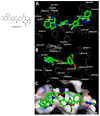Design and Activity of Novel Oxadiazole Based Compounds That Target Poly(ADP-ribose) Polymerase
- PMID: 35163965
- PMCID: PMC8839658
- DOI: 10.3390/molecules27030703
Design and Activity of Novel Oxadiazole Based Compounds That Target Poly(ADP-ribose) Polymerase
Abstract
Novel PARP inhibitors with selective mode-of-action have been approved for clinical use. Herein, oxadiazole based ligands that are predicted to target PARP-1 have been synthesized and screened for the loss of cell viability in mammary carcinoma cells, wherein seven compounds were observed to possess significant IC50 values in the range of 1.4 to 25 µM. Furthermore, compound 5u, inhibited the viability of MCF-7 cells with an IC50 value of 1.4µM, when compared to Olaparib (IC50 = 3.2 µM). Compound 5s also decreased cell viability in MCF-7 and MDA-MB-231 cells with IC50 values of 15.3 and 19.2 µM, respectively. Treatment of MCF-7 cells with compounds 5u and 5s produced PARP cleavage, H2AX phosphorylation and CASPASE-3 activation comparable to that observed with Olaparib. Compounds 5u and 5s also decreased foci-formation and 3D Matrigel growth of MCF-7 cells equivalent to or greater than that observed with Olaparib. Finally, in silico analysis demonstrated binding of compound 5s towardsthe catalytic site of PARP-1, indicating that these novel oxadiazoles synthesized herein may serve as exemplars for the development of new therapeutics in cancer.
Keywords: human breast cancer; nicotinamide; oxadiazole; poly(ADP-ribose) polymerase.
Conflict of interest statement
The authors declare no conflict of interest.
Figures








Similar articles
-
Identification of novel PARP-1 inhibitors: Drug design, synthesis and biological evaluation.Bioorg Med Chem Lett. 2015 Oct 15;25(20):4557-61. doi: 10.1016/j.bmcl.2015.08.060. Epub 2015 Aug 22. Bioorg Med Chem Lett. 2015. PMID: 26342868
-
Discovery of 2-(1-(3-(4-Chloroxyphenyl)-3-oxo- propyl)pyrrolidine-3-yl)-1H-benzo[d]imidazole-4-carboxamide: A Potent Poly(ADP-ribose) Polymerase (PARP) Inhibitor for Treatment of Cancer.Molecules. 2019 May 17;24(10):1901. doi: 10.3390/molecules24101901. Molecules. 2019. PMID: 31108884 Free PMC article.
-
Blocking c-Met-mediated PARP1 phosphorylation enhances anti-tumor effects of PARP inhibitors.Nat Med. 2016 Feb;22(2):194-201. doi: 10.1038/nm.4032. Epub 2016 Jan 18. Nat Med. 2016. PMID: 26779812 Free PMC article.
-
An Update on Poly(ADP-ribose)polymerase-1 (PARP-1) Inhibitors: Opportunities and Challenges in Cancer Therapy.J Med Chem. 2016 Nov 10;59(21):9575-9598. doi: 10.1021/acs.jmedchem.6b00055. Epub 2016 Jul 27. J Med Chem. 2016. PMID: 27416328 Review.
-
A Review on Poly (ADP-ribose) Polymerase (PARP) Inhibitors and Synthetic Methodologies.Curr Med Chem. 2021;28(8):1565-1584. doi: 10.2174/0929867327666200312113011. Curr Med Chem. 2021. PMID: 32164505 Review.
Cited by
-
Discovery of oxazine-linked pyrimidine as an inhibitor of breast cancer growth and metastasis by abrogating NF-κB activation.Front Oncol. 2024 Jul 29;14:1390992. doi: 10.3389/fonc.2024.1390992. eCollection 2024. Front Oncol. 2024. PMID: 39135991 Free PMC article.
-
A Theoretical Study of the Interaction of PARP-1 with Natural and Synthetic Inhibitors: Advances in the Therapy of Triple-Negative Breast Cancer.Curr Issues Mol Biol. 2024 Aug 27;46(9):9415-9429. doi: 10.3390/cimb46090558. Curr Issues Mol Biol. 2024. PMID: 39329910 Free PMC article.
-
Development of 1-(4-(Substituted)piperazin-1-yl)-2-((2-((4-methoxybenzyl)thio)pyrimidin-4-yl)oxy)ethanones That Target Poly (ADP-Ribose) Polymerase in Human Breast Cancer Cells.Molecules. 2022 Apr 29;27(9):2848. doi: 10.3390/molecules27092848. Molecules. 2022. PMID: 35566199 Free PMC article.
-
Background-Quenched Aggregation-Induced Emission through Electrostatic Interactions for the Detection of Poly(ADP-ribose) Polymerase-1 Activity.Molecules. 2023 Jun 14;28(12):4759. doi: 10.3390/molecules28124759. Molecules. 2023. PMID: 37375313 Free PMC article.
References
MeSH terms
Substances
LinkOut - more resources
Full Text Sources
Research Materials
Miscellaneous

